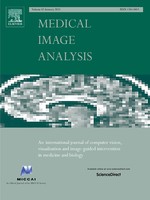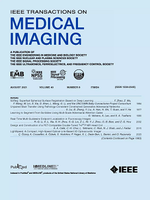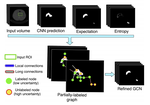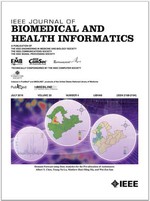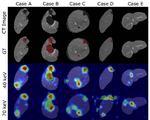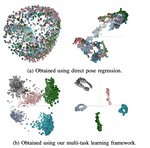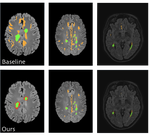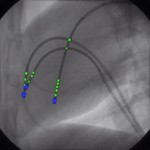FUTURE-AI: International consensus guideline for trustworthy and deployable artificial intelligence in healthcare
The FUTURE-AI paper presents an international consensus guideline aimed at ensuring the trustworthiness and effective deployment of artificial intelligence (AI) tools in healthcare. Published in The BMJ in February 2024, this framework addresses the technical, clinical, ethical, and legal challenges associated with integrating AI into clinical practice
Lvm-med: Learning large-scale self-supervised vision models for medical imaging via second-order graph matching
Obtaining large pre-trained models that can be fine-tuned to new tasks with limited annotated samples has remained an open challenge …
Guest Editorial Special Issue on Federated Learning for Medical Imaging: Enabling Collaborative Development of Robust AI Models
Federated Learning (FL) could solve the challenges of training AI models on large datasets for medical imaging due to data privacy and …
Digital staining of white blood cells with confidence estimation
Chemical staining of the blood smears is one of the crucial components of blood analysis. It is an expensive, lengthy and sensitive …
Federated disentangled representation learning for unsupervised brain anomaly detection
With the advent of deep learning and increasing use of brain MRIs, a great amount of interest has arisen in automated anomaly …
FLamby: Datasets and Benchmarks for Cross-Silo Federated Learning in Realistic Healthcare Settings
Federated Learning (FL) is a novel approach enabling several clients holding sensitive data to collaboratively train machine learning …
Joint Self-Supervised Image-Volume Representation Learning with Intra-Inter Contrastive Clustering
Collecting large-scale medical datasets with fully annotated samples for training of deep networks is prohibitively expensive, …
Federated disentangled representation learning for unsupervised brain anomaly detection
With the advent of deep learning and increasing use of brain MRIs, a great amount of interest has arisen in automated anomaly …
What can we learn about a generated image corrupting its latent representation?
Generative adversarial networks (GANs) offer an effective solution to the image-to-image translation problem, thereby allowing for new …
FedPerl: Semi-Supervised Peer Learning for Skin Lesion Classification
Skin cancer is one of the most deadly cancers worldwide. Yet, it can be reduced by early detection. Recent deep-learning methods have …
Federated Disentangled Representation Learning for Unsupervised Brain Anomaly Detection
Recent advances in Deep Learning (DL) and the increased use of brain MRI have provided a great opportunity and interest in automated …
Autoencoders for Unsupervised Anomaly Segmentation in Brain MR Images: A Comparative Study
Deep unsupervised representation learning has recently led to new approaches in the field of Unsupervised Anomaly Detection (UAD) in …
Multi-task multi-domain learning for digital staining and classification of leukocytes
oking stained images preserving the inter-cellular structures, crucial for the medical experts to perform classification. We achieve …
An Uncertainty-Driven GCN Refinement Strategy for Organ Segmentation
Organ segmentation in CT volumes is an important pre-processing step in many computer assisted intervention and diagnosis methods. In …
The Future of Digital Health with Federated Learning
Data-driven Machine Learning has emerged as a promising approach for building accurate and robust statistical models from medical data, …
Fairness by Learning Orthogonal Disentangled Representations
Learning discriminative powerful representations is a crucial step for machine learning systems. Introducing invariance against …
6D Camera Relocalization in Ambiguous Scenes via Continuous Multimodal Inference
We present a multimodal camera relocalization framework that captures ambiguities and uncertainties with continuous mixture models …
Uncertainty-based graph convolutional networks for organ segmentation refinement
Organ segmentation is an important pre-processing step in many computer assisted intervention and diagnosis methods. In recent years, …
Seamless Virtual Whole Slide Image Synthesis and Validation Using Perceptual Embedding Consistency
Stain virtualization is an application with growing interest in digital pathology allowing simulation of stained tissue images thus …
Image-to-Images Translation for Multi-Task Organ Segmentation and Bone Suppression in Chest X-Ray Radiography
Chest X-ray radiography is one of the earliest medical imaging technologies and remains one of the most widely-used for diagnosis, …
Benefit of dual energy CT for lesion localization and classification with convolutional neural networks
Dual Energy CT is a modern imaging technique that is utilized in clinical practice to acquire spectral information for various …
An objective comparison of detection and segmentation algorithms for artefacts in clinical endoscopy
We present a comprehensive analysis of the submissions to the first edition of the Endoscopy Artefact Detection challenge (EAD). Using …
A learning without forgetting approach to incorporate artifact knowledge in polyp localization tasks
Colorectal polyps are abnormalities in the colon tissue that can develop into colorectal cancer. The survival rate for patients is …
Virtualization of tissue staining in digital pathology using an unsupervised deep learning approach
Histopathological evaluation of tissue samples is a key practice in patient diagnosis and drug development, especially in oncology. …
Towards an Interactive and Interpretable CAD System to Support Proximal Femur Fracture Classification
We demonstrate the feasibility of a fully automatic computer-aided diagnosis (CAD) tool, based on deep learning, that localizes and …
Staingan: Stain style transfer for digital histological images
Digitized Histological diagnosis is in increasing demand. However, color variations due to various factors are imposing obstacles to …
Semi-Supervised Few-Shot Learning with Prototypical Random Walks
Recent progress has shown that few-shot learning can be improved with access to unlabelled data, known as semi-supervised few-shot …
Self-attention equipped graph convolutions for disease prediction
Multi-modal data comprising imaging (MRI, fMRI, PET, etc.) and non-imaging (clinical test, demographics, etc.) data can be collected …
Perceptual Embedding Consistency for Seamless Reconstruction of Tilewise Style Transfer
Style transfer is a field with growing interest and use cases in deep learning. Recent work has shown Generative Adversarial …
Multi-scale Microaneurysms Segmentation Using Embedding Triplet Loss
Deep learning techniques are recently being used in fundus image analysis and diabetic retinopathy detection. Microaneurysms are an …
Learning Interpretable Features via Adversarially Robust Optimization
Neural networks are proven to be remarkably successful for classification and diagnosis in medical applications. However, the ambiguity …
Learning interpretable disentangled representations using adversarial vaes
Learning Interpretable representation in medical applications is becoming essential for adopting data-driven models into clinical …
Learn to Segment Organs with a Few Bounding Boxes
Semantic segmentation is an import task in the medical field to identify the exact extent and orientation of significant structures …
InceptionGCN: receptive field aware graph convolutional network for disease prediction
Geometric deep learning provides a principled and versatile manner for the integration of imaging and non-imaging modalities in the …
Graph Convolution Based Attention Model for Personalized Disease Prediction
Clinicians implicitly incorporate the complementarity of multi-modal data for disease diagnosis. Often a varied order of importance for …
Fusing unsupervised and supervised deep learning for white matter lesion segmentation
Unsupervised Deep Learning for Medical Image Analysis is increasingly gaining attention, since it relieves from the need for annotating …
Adversarial Networks for Camera Pose Regression and Refinement
Despite recent advances on the topic of direct camera pose regression using neural networks, accurately estimating the camera pose of a …
Adaptive image-feature learning for disease classification using inductive graph networks
Recently, Geometric Deep Learning (GDL) has been introduced as a novel and versatile framework for computer-aided disease …
When regression meets manifold learning for object recognition and pose estimation
In this work, we propose a method for object recognition and pose estimation from depth images using convolutional neural networks. …
Scene coordinate and correspondence learning for image-based localization
Scene coordinate regression has become an essential part of current camera re-localization methods. Different versions, such as …
Generating highly realistic images of skin lesions with GANs
As many other machine learning driven medical image analysis tasks, skin image analysis suffers from a chronic lack of labeled data and …
Fine-Tuning Deep Learning by Crowd Participation
One of the major challenges currently facing researchers in applying deep learning (DL) models to medical image analysis is the limited …
Domain and geometry agnostic CNNs for left atrium segmentation in 3D ultrasound
Segmentation of the left atrium and deriving its size can help to predict and detect various cardiovascular conditions. Automation of …
Deep autoencoding models for unsupervised anomaly segmentation in brain MR images
Reliably modeling normality and differentiating abnormal appearances from normal cases is a very appealing approach for detecting …
Capsule networks against medical imaging data challenges
A key component to the success of deep learning is the availability of massive amounts of training data. Building and annotating large …
X-Ray PoseNet: 6 DoF pose estimation for mobile X-Ray devices
Precise reconstruction of 3D volumes from X-ray projections requires precisely pre-calibrated systems where accurate knowledge of the …
X-ray in-depth decomposition: Revealing the latent structures
X-ray is the most readily available imaging modality and has a broad range of applications that spans from diagnosis to intra-operative …
Semi-supervised deep learning for fully convolutional networks
Deep learning usually requires large amounts of labeled training data, but annotating data is costly and tedious. The framework of …


